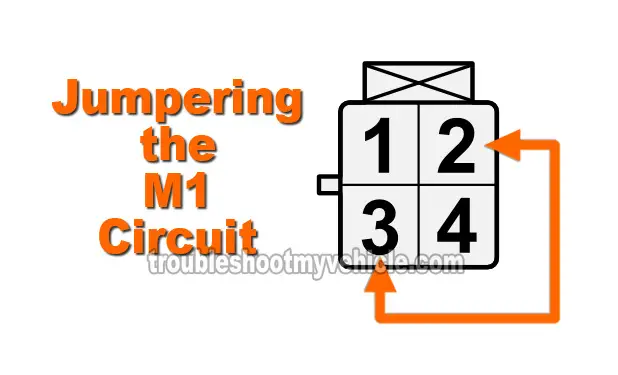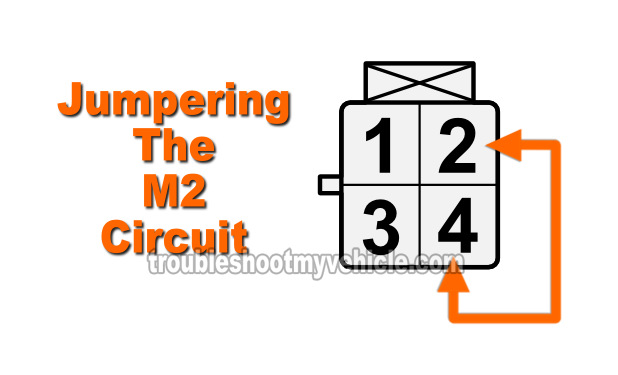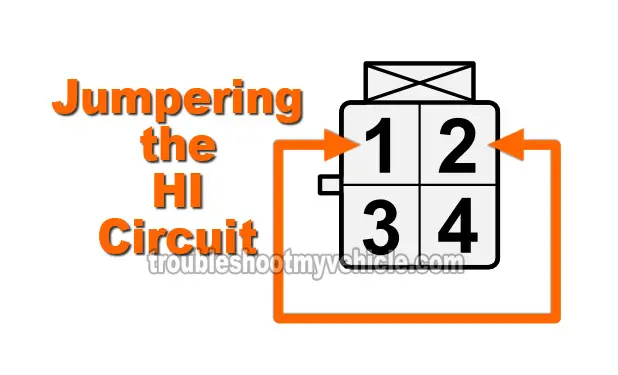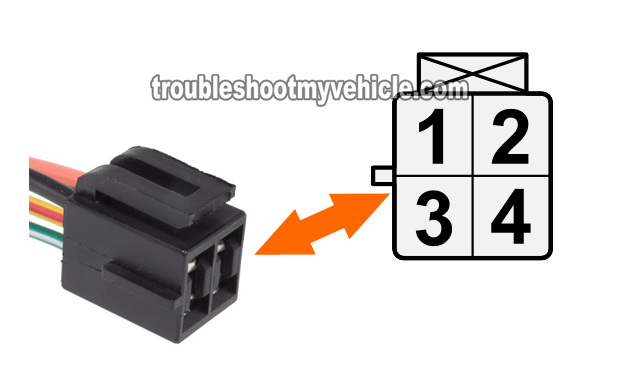TEST 2: Using A Jumper Wire To Bypass The Blower Switch
Bypassing your Ford's blower motor switch is a pretty easy thing to do and only requires a small jumper wire.
In case you're wondering, bypassing the blower switch will let us know (in an indirect manner) if the blower motor resistor is OK.
IMPORTANT: To avoid damaging the blower switch connector's female metal terminals you should use a small diameter wire as a jumper wire.
NOTE: All of the tests below require that the A/C Heater control panel vent knob not be in the OFF position. In the OFF position, the ORG/BLK wire of the blower switch will NOT get power and this wire needs power for the tests to work.
Alright, these are the test steps:
- 1
Disconnect the blower switch from its harness connector and turn the key to the on position (but no need to start the engine).
NOTE: All of the tests in this section are done on the blower switch's harness connector and not on the switch itself. The illustrations in the image viewer show the front view of the female metal terminals of the connector. - 2
Jumper terminals 2 and 3 together. This is jumpering the ORG/BLK and LT GRN/WHT wires together. This is the circuit that controls blower speed M1.
The correct test result is for the blower motor to run on M1 speed. - 3
Jumper terminals 2 and 4 together. This is jumpering the ORG/BLK and YEL/RED wires together. This is the circuit that controls blower speed M2.
The correct test result is for the blower motor to run on M2 speed. - 4
Jumper terminals 2 and 1 together. This is jumpering the ORG/BLK and BLK wires together. This is the circuit that controls blower speed HI.
The correct test result is for the blower motor to run on HI speed.
Let's take a look at what your test results mean:
CASE 1: The blower motor DID NOT run when two or all of the indicated terminals were jumpered. This tells you that that specific circuit is bad.
Although it's beyond the scope of this tutorial to test these circuits, you have eliminated the blower switch (on the A/C-Heater control panel) as bad. There's a good chance that you've got a bad blower motor resistor.
The blower resistor can be tested and the following diagnostic tutorial may be of help:
CASE 2: The blower motor ran when all of the indicated terminals were jumpered together. This tells you several important things:
- That the circuits between the resistor connector and the blower motor are OK.
- That the blower motor relay is OK.
No further testing is required of the blower resistor, the blower relay or the blower motor.
More Ford 4.6L, 5.4L Diagnostic Tutorials
If you enjoyed and/or found this ‘How To' article helpful, I have written several more Ford 4.6L, 5.4L specific test articles. You can find them all in this index: Ford 4.6L, 5.4L Index Of Articles
Here's a small sample of the articles you'll find there:
- How To Test The Fuel Pump -No Start Test (Ford 4.6L, 5.4L).
- How To Test The Crankshaft Position Sensor (Ford 4.6L, 5.4L).
- How To Test Ford Coil-On-Plug Ignition Coils 4.6L and 5.4L V8 Engines (at: easyautodiagnostics.com).
- How To Test The Throttle Position Sensor Ford, Mercury, Lincoln 4.6L and 5.4L Engines (at: easyautodiagnostics.com).
- How To Test The FORD MAF 4.2L, 4.6L, 5.4L Round Air Filter Canister Assembly MAF Sensor (at: easyautodiagnostics.com).
- How To Test Ford MAF Sensors Using A Multimeter (at: easyautodiagnostics.com).

If this info saved the day, buy me a beer!





